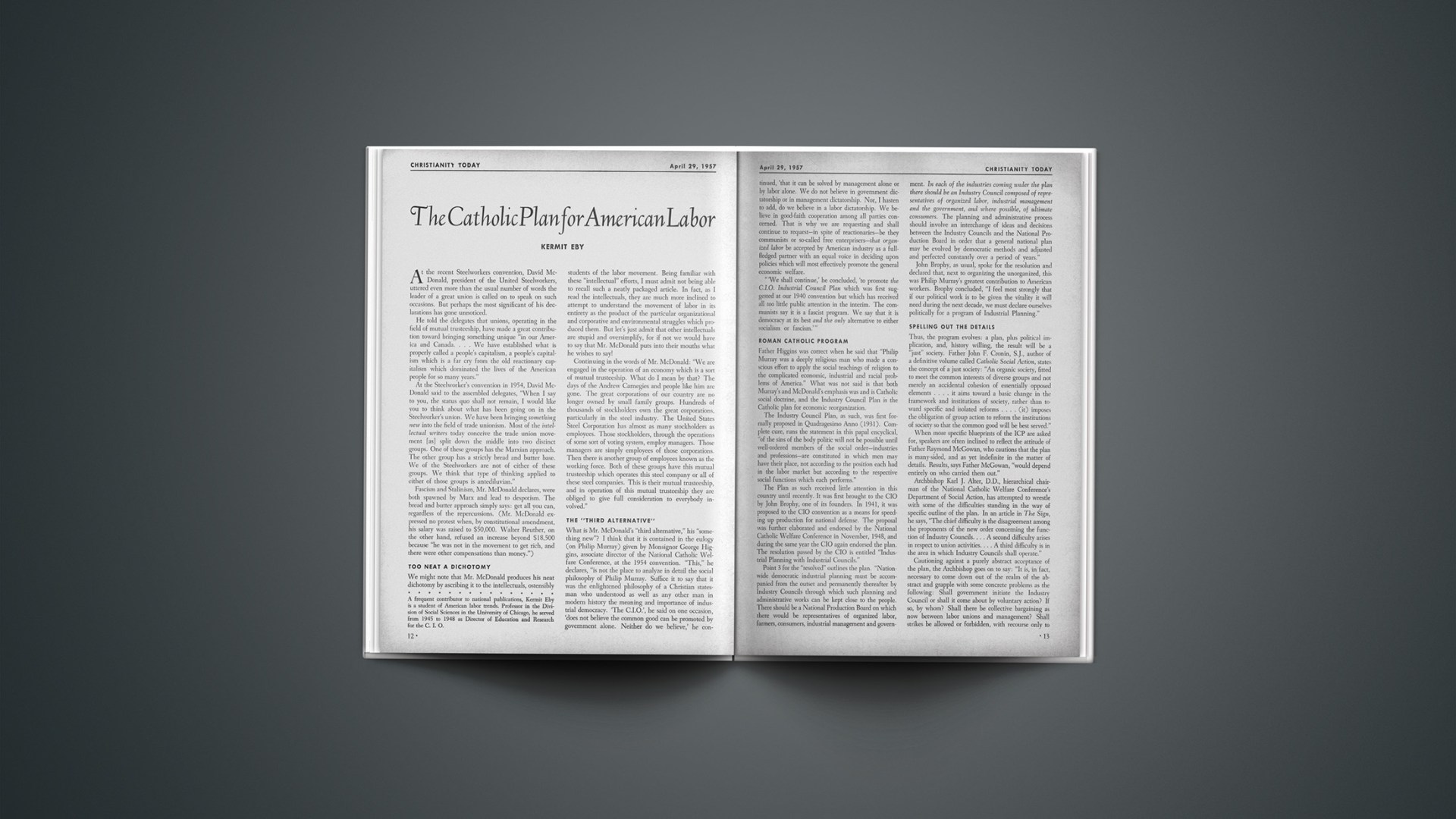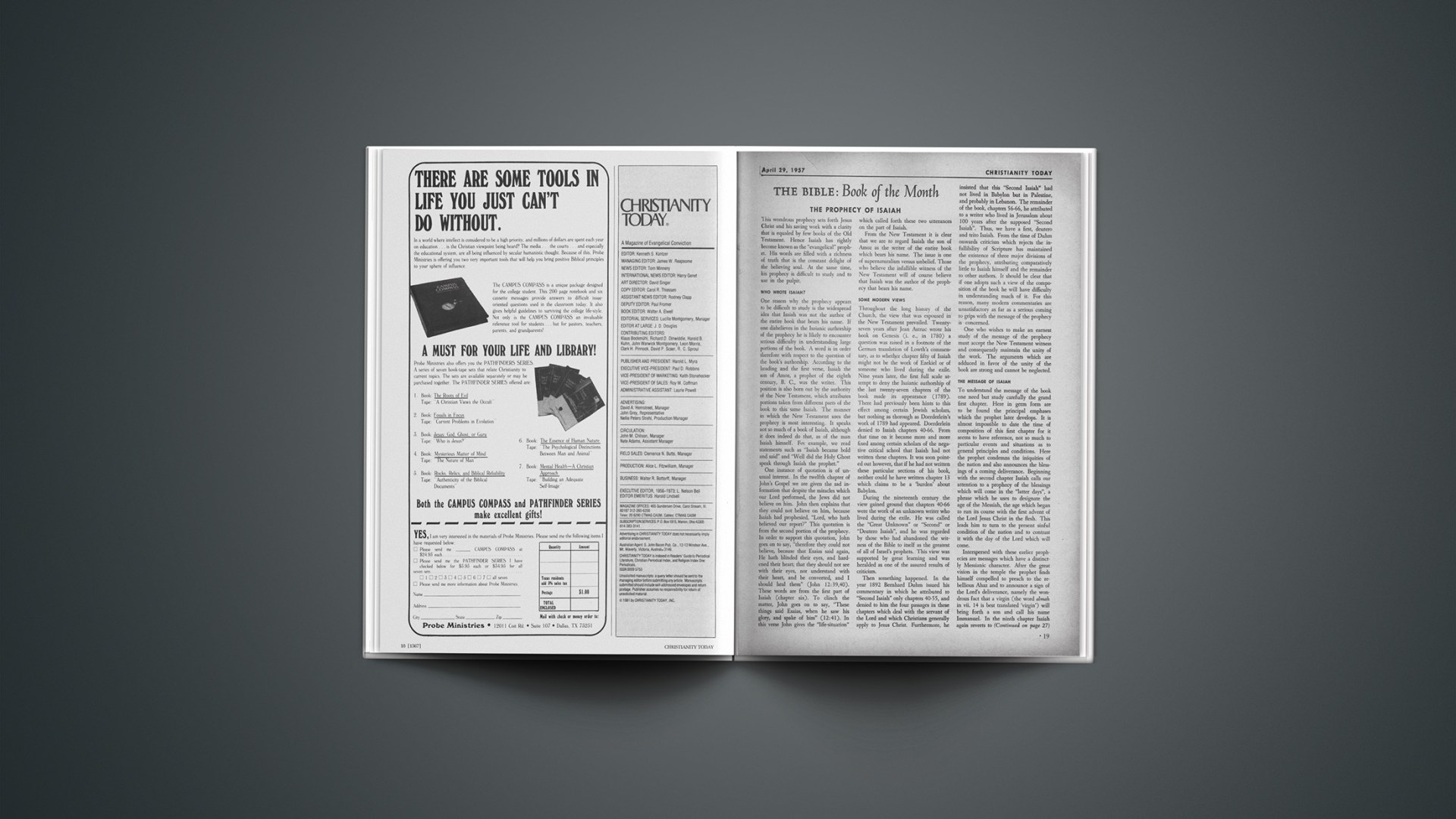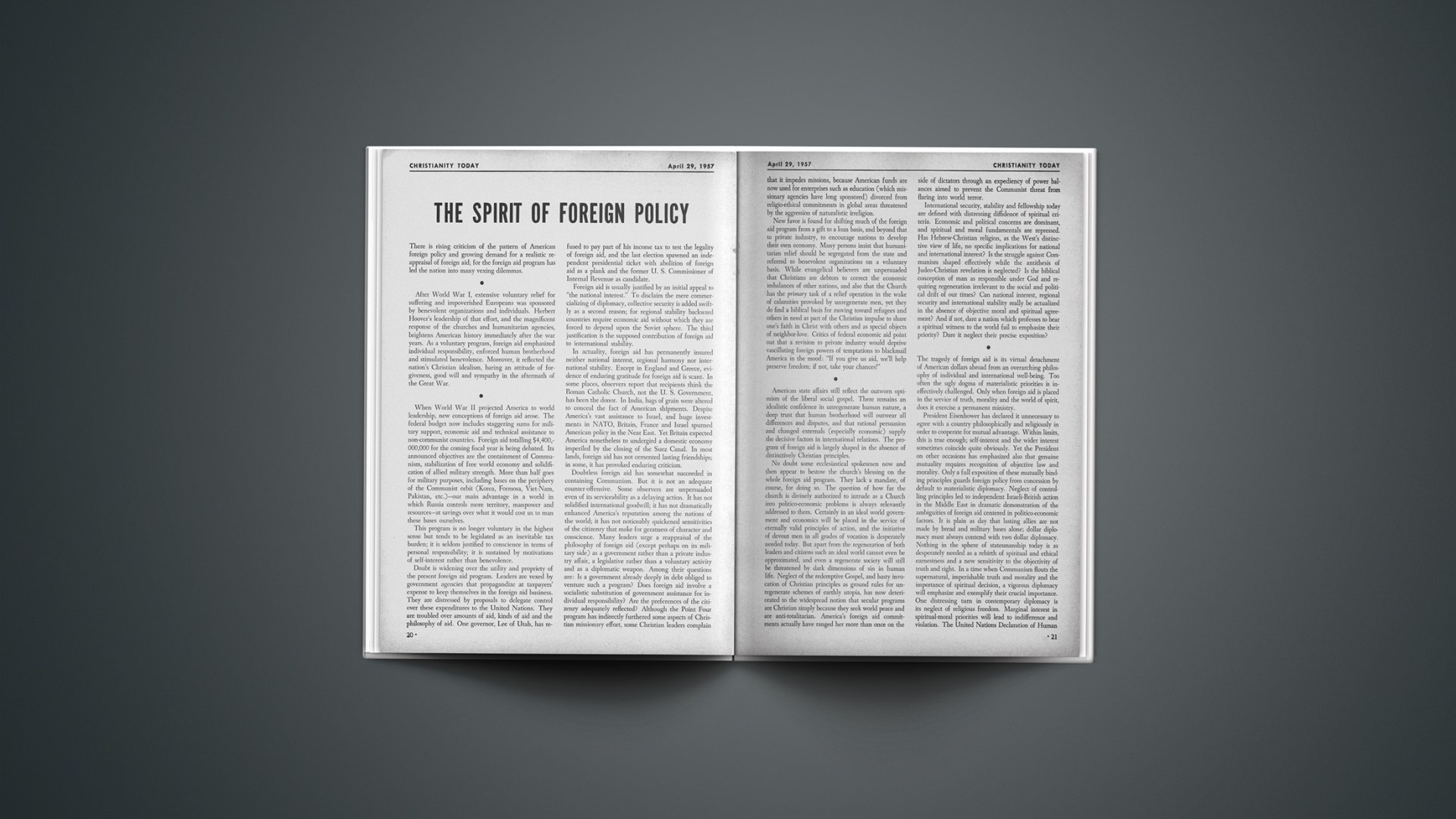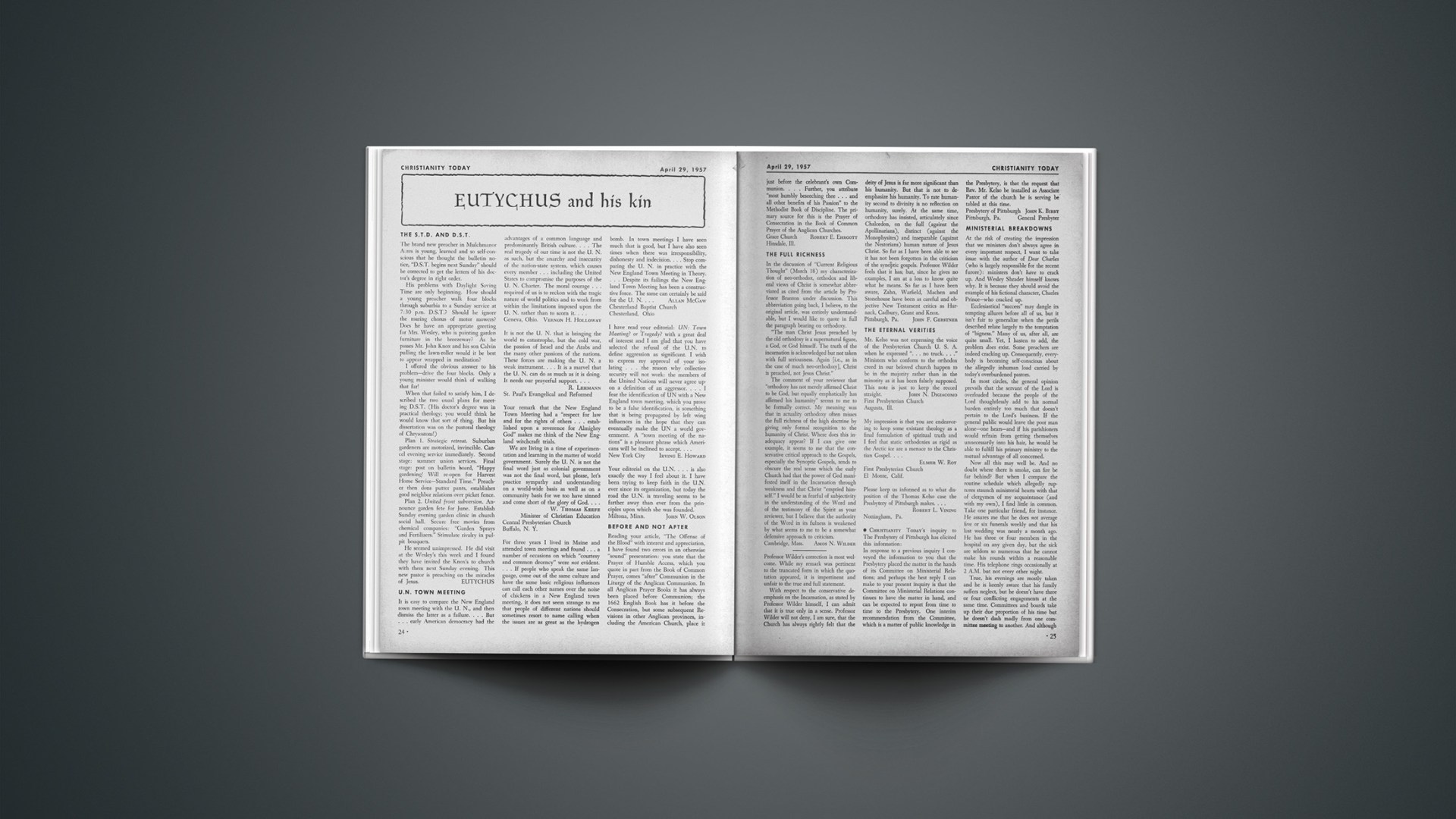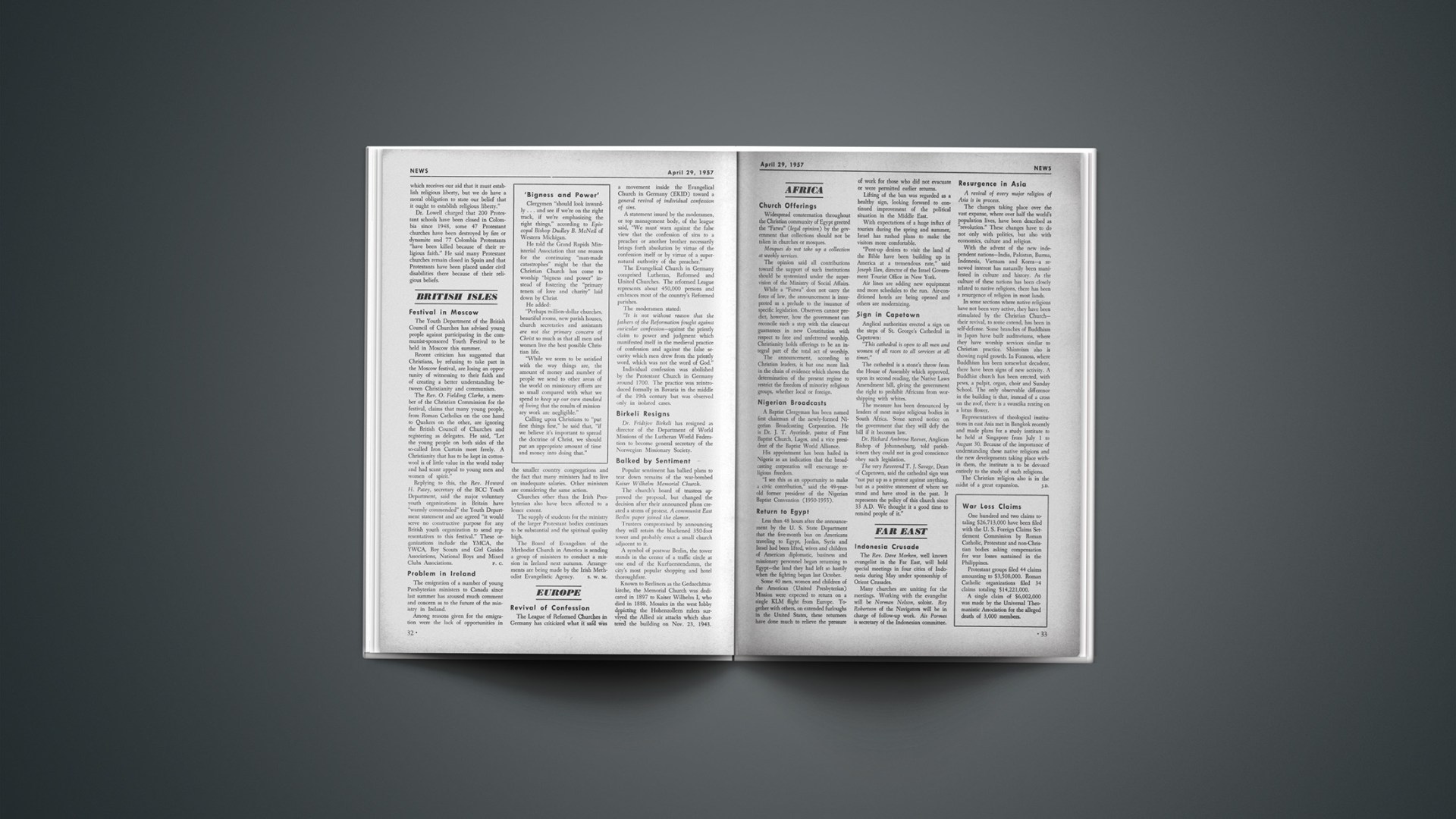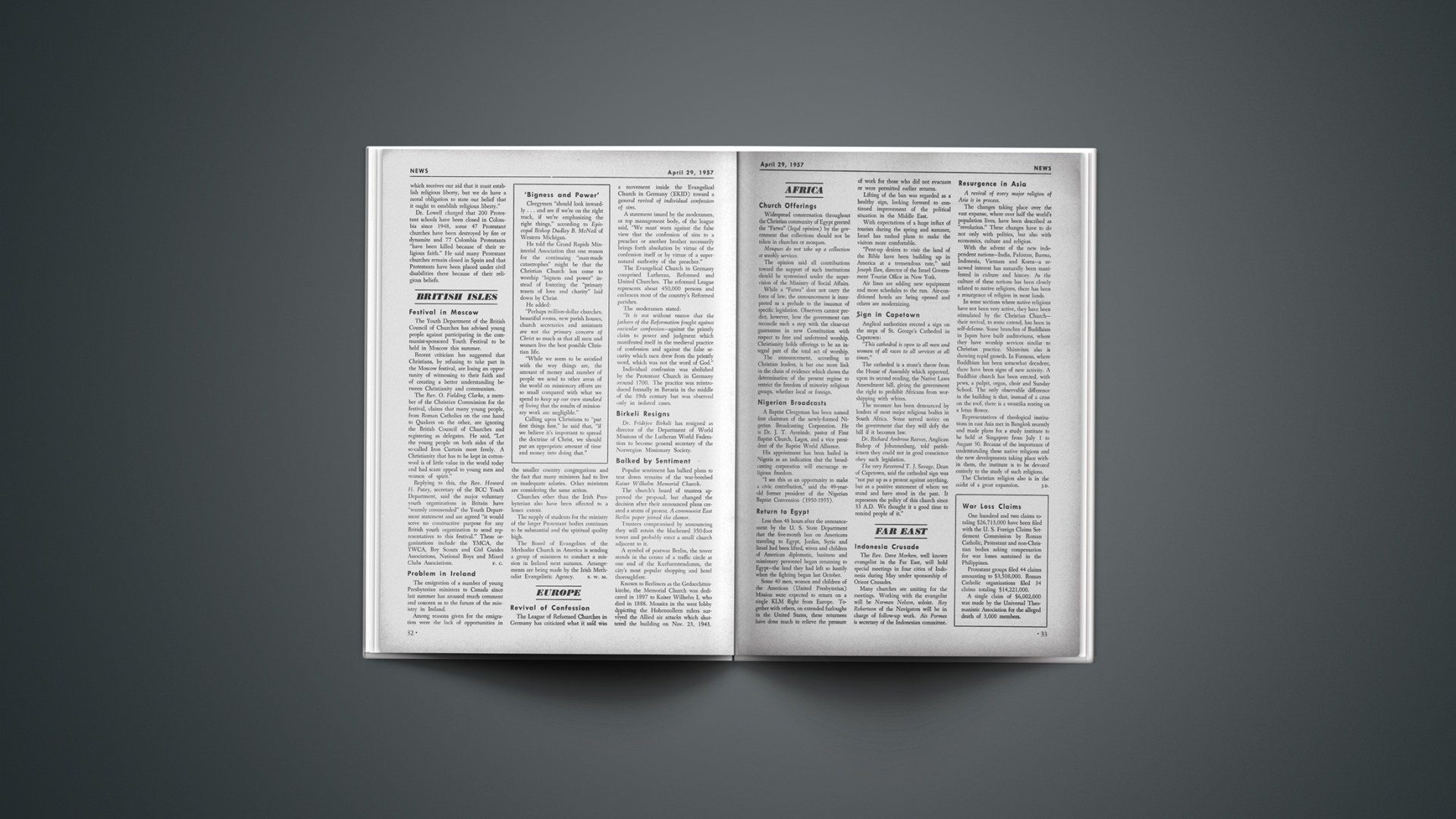At the recent Steelworkers convention, David McDonald, president of the United Steelworkers, uttered even more than the usual number of words the leader of a great union is called on to speak on such occasions. But perhaps the most significant of his declarations has gone unnoticed.
He told the delegates that unions, operating in the field of mutual trusteeship, have made a great contribution toward bringing something unique “in our America and Canada.… We have established what is properly called a people’s capitalism, a people’s capitalism which is a far cry from the old reactionary capitalism which dominated the lives of the American people for so many years.”
At the Steelworker’s convention in 1954, David McDonald said to the assembled delegates, “When I say to you, the status quo shall not remain, I would like you to think about what has been going on in the Steelworker’s union. We have been bringing something new into the field of trade unionism. Most of the intellectual writers today conceive the trade union movement [as] split down the middle into two distinct groups. One of these groups has the Marxian approach. The other group has a strictly bread and butter base. We of the Steelworkers are not of either of these groups. We think that type of thinking applied to either of those groups is antediluvian.”
Fascism and Stalinism, Mr. McDonald declares, were both spawned by Marx and lead to despotism. The bread and butter approach simply says: get all you can, regardless of the repercussions. (Mr. McDonald expressed no protest when, by constitutional amendment, his salary was raised to $50,000. Walter Reuther, on the other hand, refused an increase beyond $18,500 because “he was not in the movement to get rich, and there were other compensations than money.”)
Too Neat A Dichotomy
We might note that Mr. McDonald produces his neat dichotomy by ascribing it to the intellectuals, ostensibly students of the labor movement. Being familiar with these “intellectual” efforts, I must admit not being able to recall such a neatly packaged article. In fact, as I read the intellectuals, they are much more inclined to attempt to understand the movement of labor in its entirety as the product of the particular organizational and corporative and environmental struggles which produced them. But let’s just admit that other intellectuals are stupid and oversimplify, for if not we would have to say that Mr. McDonald puts into their mouths what he wishes to say!
Continuing in the words of Mr. McDonald: “We are engaged in the operation of an economy which is a sort of mutual trusteeship. What do I mean by that? The days of the Andrew Carnegies and people like him are gone. The great corporations of our country are no longer owned by small family groups. Hundreds of thousands of stockholders own the great corporations, particularly in the steel industry. The United States Steel Corporation has almost as many stockholders as employees. Those stockholders, through the operations of some sort of voting system, employ managers. Those managers are simply employees of those corporations. Then there is another group of employees known as the working force. Both of these groups have this mutual trusteeship which operates this steel company or all of these steel companies. This is their mutual trusteeship, and in operation of this mutual trusteeship they are obliged to give full consideration to everybody involved.”
The “Third Alternative”
What is Mr. McDonald’s “third alternative,” his “something new”? I think that it is contained in the eulogy (on Philip Murray) given by Monsignor George Higgins, associate director of the National Catholic Welfare Conference, at the 1954 convention. “This,” he declares, “is not the place to analyze in detail the social philosophy of Philip Murray. Suffice it to say that it was the enlightened philosophy of a Christian statesman who understood as well as any other man in modern history the meaning and importance of industrial democracy. ‘The C.I.O.’, he said on one occasion, ‘does not believe the common good can be promoted by government alone. Neither do we believe,’ he continued, ‘that it can be solved by management alone or by labor alone. We do not believe in government dictatorship or in management dictatorship. Nor, I hasten to add, do we believe in a labor dictatorship. We believe in good-faith cooperation among all parties concerned. That is why we are requesting and shall continue to request—in spite of reactionaries—be they communists or so-called free enterprisers—that organized labor be accepted by American industry as a full-fledged partner with an equal voice in deciding upon policies which will most effectively promote the general economic welfare.
“ ‘We shall continue,’ he concluded, ‘to promote the C.I.O. Industrial Council Plan which was first suggested at our 1940 convention but which has received all too little public attention in the interim. The communists say it is a fascist program. We say that it is democracy at its best and the only alternative to either socialism or fascism.’ ”
Roman Catholic Program
Father Higgins was correct when he said that “Philip Murray was a deeply religious man who made a conscious effort to apply the social teachings of religion to the complicated economic, industrial and racial problems of America.” What was not said is that both Murray’s and McDonald’s emphasis was and is Catholic social doctrine, and the Industry Council Plan is the Catholic plan for economic reorganization.
The Industry Council Plan, as such, was first formally proposed in Quadragesimo Anno (1931). Complete cure, runs the statement in this papal encyclical, “of the sins of the body politic will not be possible until well-ordered members of the social order—industries and professions—are constituted in which men may have their place, not according to the position each had in the labor market but according to the respective social functions which each performs.”
The Plan as such received little attention in this country until recently. It was first brought to the CIO by John Brophy, one of its founders. In 1941, it was proposed to the CIO convention as a means for speeding up production for national defense. The proposal was further elaborated and endorsed by the National Catholic Welfare Conference in November, 1948, and during the same year the CIO again endorsed the plan. The resolution passed by the CIO is entitled “Industrial Planning with Industrial Councils.”
Point 3 for the “resolved” outlines the plan. “Nationwide democratic industrial planning must be accompanied from the outset and permanently thereafter by Industry Councils through which such planning and administrative works can be kept close to the people. There should be a National Production Board on which there would be representatives of organized labor, farmers, consumers, industrial management and government. In each of the industries coming under the plan there should be an Industry Council composed of representatives of organized labor, industrial management and the government, and where possible, of ultimate consumers. The planning and administrative process should involve an interchange of ideas and decisions between the Industry Councils and the National Production Board in order that a general national plan may be evolved by democratic methods and adjusted and perfected constantly over a period of years.”
John Brophy, as usual, spoke for the resolution and declared that, next to organizing the unorganized, this was Philip Murray’s greatest contribution to American workers. Brophy concluded, “I feel most strongly that if our political work is to be given the vitality it will need during the next decade, we must declare ourselves politically for a program of Industrial Planning.”
Spelling Out The Details
Thus, the program evolves: a plan, plus political implication, and, history willing, the result will be a “just” society. Father John F. Cronin, S.J., author of a definitive volume called Catholic Social Action, states the concept of a just society: “An organic society, fitted to meet the common interests of diverse groups and not merely an accidental cohesion of essentially opposed elements.… it aims toward a basic change in the framework and institutions of society, rather than toward specific and isolated reforms.… (it) imposes the obligation of group action to reform the institutions of society so that the common good will be best served.” When more specific blueprints of the ICP are asked for, speakers are often inclined to reflect the attitude of Father Raymond McGowan, who cautions that the plan is many-sided, and as yet indefinite in the matter of details. Results, says Father McGowan, “would depend entirely on who carried them out.”
Archbishop Karl J. Alter, D.D., hierarchical chairman of the National Catholic Welfare Conference’s Department of Social Action, has attempted to wrestle with some of the difficulties standing in the way of specific outline of the plan. In an article in The Sign, he says, “The chief difficulty is the disagreement among the proponents of the new order concerning the function of Industry Councils.… A second difficulty arises in respect to union activities.… A third difficulty is in the area in which Industry Councils shall operate.” Cautioning against a purely abstract acceptance of the plan, the Archbishop goes on to say: “It is, in fact, necessary to come down out of the realm of the abstract and grapple with some concrete problems as the following: Shall government initiate the Industry Council or shall it come about by voluntary action? If so, by whom? Shall there be collective bargaining as now between labor unions and management? Shall strikes be allowed or forbidden, with recourse only to labor courts? What rights shall owners retain as distinct from those of the Industry Council? Shall labor unions be sanctioned?… We know that there is far more to the Industry Council system than this, but we shall make more rapid progress if we remove the obsecurity surrounding some of these questions.”
Some Concrete Steps
Vague as the Plan still seems to be, concrete steps toward the organization of it have been taken. The National Industry Council Association, Inc., has been set up “to encourage and participate in the establishment of the councils of employers, employees and the public, suggested in the Papal social encyclicals as the Christian way of regulating industrial strife.” Acting as the educational guide of the National Industry Council Association is Father William J. Kelly, O.M.I., of Buffalo, former member of the New York State Labor Relations Board and a renowned arbitrator.
In Europe, as early as 1949, rapid progress toward legislative enactment of the Plan had been made. In 1949 the Belgian parliament passed a law promoting the establishment of an industry council system. Similar action was taken in Holland. From Germany, Bishop Aloijsius J. Muench, Regent of the Apostolic Nunciature in Germany, wrote in April, 1950, “In Germany a revolutionary change is in the making. It is proposed that labor become a sharer with capital in the management of the enterprise in which both are employed. Instead of giving to capital, that is to stockholders, the exclusive right to choose the management, labor also would obtain that right.… Labor would not only have a consultative voice but would be accorded also the right of decision. In other words, there would be a right of joint decision by the representatives of capital and of labor.… The enactment of a law recognizing the right of joint decision would make perhaps the most revolutionary change in labor relations in the twentieth century.…”
End Result Of The Plan
Catholic Action in the United States is set up in order that “men of good will” can share in “effecting the change.” This is being done not only nationally, through such groups as the National Catholic Welfare Conference and the National Catholic Rural Life Conference but also locally throughout the dioceses. Social action is a duty imposed upon every bishop and hierarchical authority in every diocese. In his book Catholic Social Action Father Cronin writes: “Normally this means that the bishop has selected one or more priests to specialize in social action work, in line with certain principles which he has laid down.” The second step is the setting up of a diocesan social action committee. This committee acts as a “front” for the clerical authorities and enables the Church to escape blame for any action that turns out to be unpopular.
Father Cronin writes on this point: “When a committee is set up in permanent form, it is important that its authority be clearly defined.… It should be accorded strong support by diocesan authorities.… At the same time it should be sufficiently detached from the diocesan curia to permit it some freedom of action. The support is necessary to win cooperation from the clergy. The limited independence frees the authorities from the necessity of making countless decisions in a specialized field. Furthermore, it permits official reversal of actions imprudently taken, even if such actions had been the subject of prior consultation with the authorities” (Italics added).
Priests chosen to work as social action directors receive special training in economics in Catholic labor schools or in the social science and industrial relations departments of Catholic universities and colleges. According to Father Cronin, the program uses “all known adult education and leadership techniques,” because, as he says, the training of leaders is “among the greatest and most urgent tasks of the American Church.” But “the training of Catholics is but a first step,” says Father Cronin. The ultimate aim is “the acceptance of a Christian social code by all groups in our society.” The Christian social code intended is, of course, the dogma of Roman Catholicism.
Although there has been official sanction given to Catholic workers joining secular labor unions (be it from expediency rather than conviction), Pius XII has reiterated a requirement made by Pius X that “side by side these unions there should be associations zealously engaged in imbuing and forming their members in the teaching of religion and morality so that they in turn may be able to permeate the unions with that good spirit which should direct them in all their activity. As a result, the religious associations will bear good fruit even beyond the circle of membership.”
The Articles of Federation of ACTU (Association of Catholic Trade Unions) state explicitly that the Association is formed for the purpose of “carrying out this [the Pope’s] mandate … to: (1) bring all Catholic working people into the unions of their occupation and choice; (2) to bring all the Catholic members into ACTU; (3) to assist the labor unions, wherever feasible, by lawful support of just demands; and (4) to spread among the people the social teachings of the Church and the idea that it is a religious duty to aid the reform of society.”
“To bear good fruit even beyond the circle of membership” and “to spread among the people the social teachings of the Church”—these are not the words of amateurs. And the difference between amateurs and professionals in the political world (as perhaps elsewhere) is that professionals not only know what they want but also know by what methods and means it is possible to get what they want.
David McDonald’s plan, the “third way,” would sanctify the obvious. Ultimately the cartelization of American industry would be complete. Then the cartels would become as powerful as the government. Power, filtering from cartel to government and back, would again give us the corporate state. If my readers do not understand how the corporate state operates, they need only study recent Indian history.
David McDonald may not understand the end results of his plan, and he may not understand the relationship between monopoly, inflation and the corporate state, but it certainly behooves every American to do so!
A frequent contributor to national publications, Kermit Eby is a student of American labor trends. Professor in the Division of Social Sciences in the University of Chicago, he served from 1945 to 1948 as Director of Education and Research for the C. I. O.

